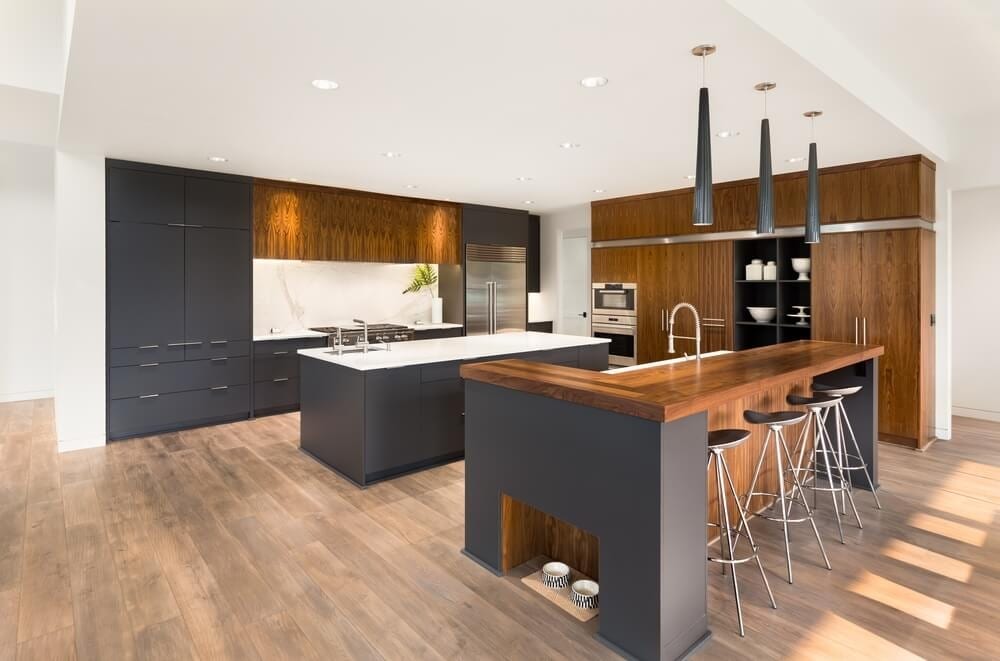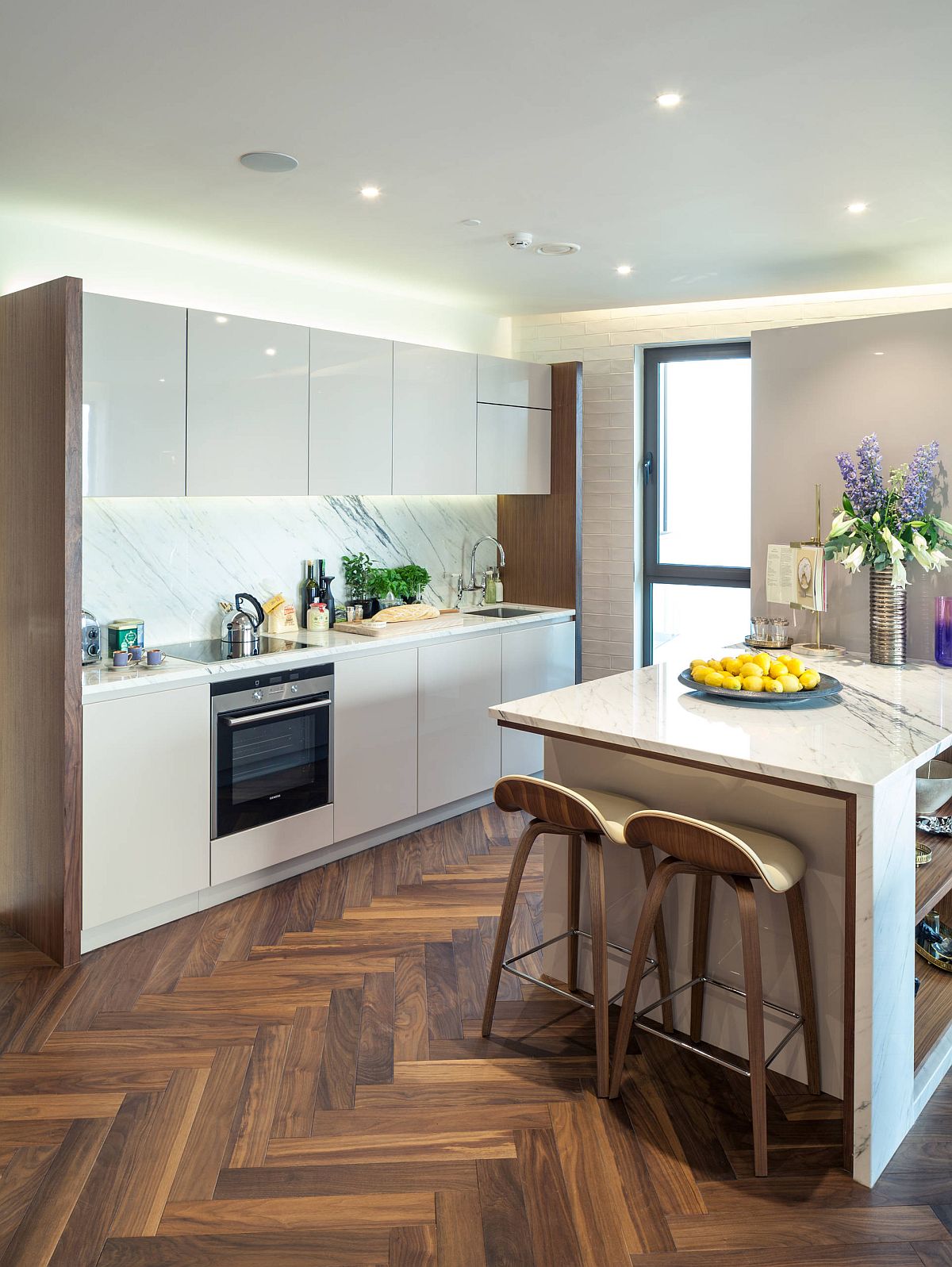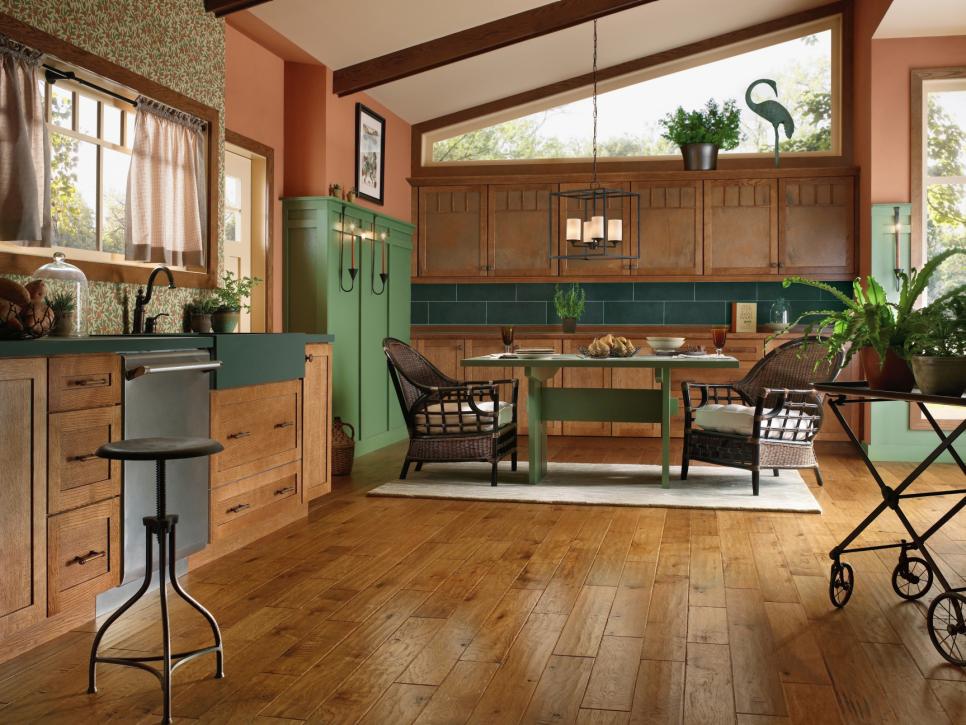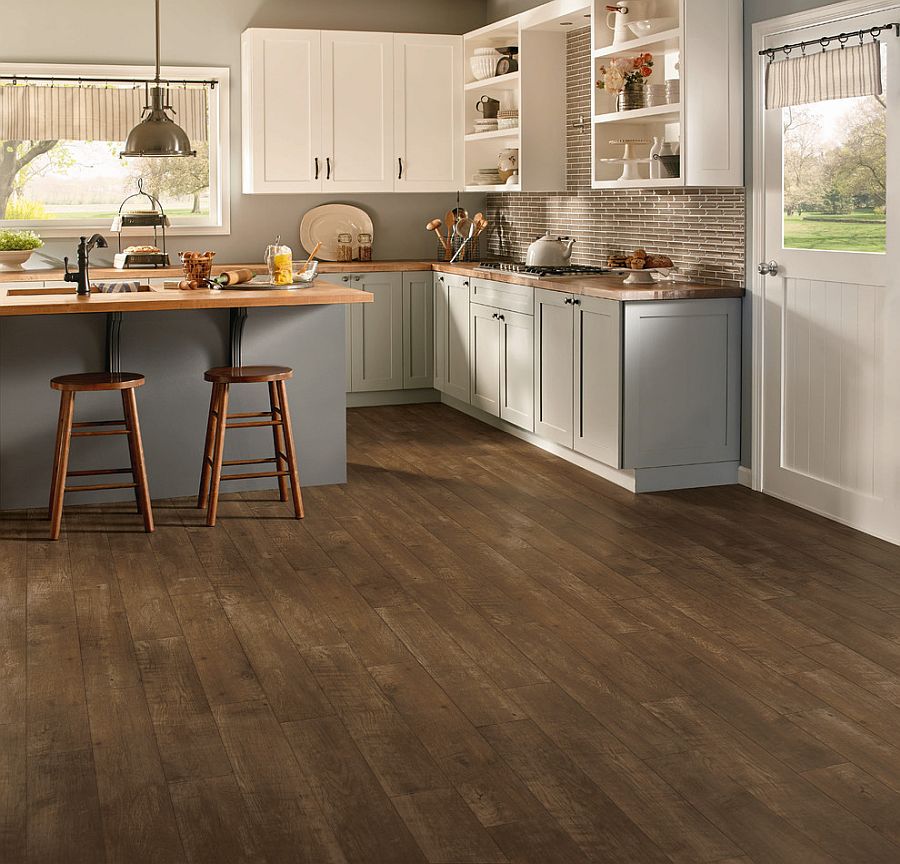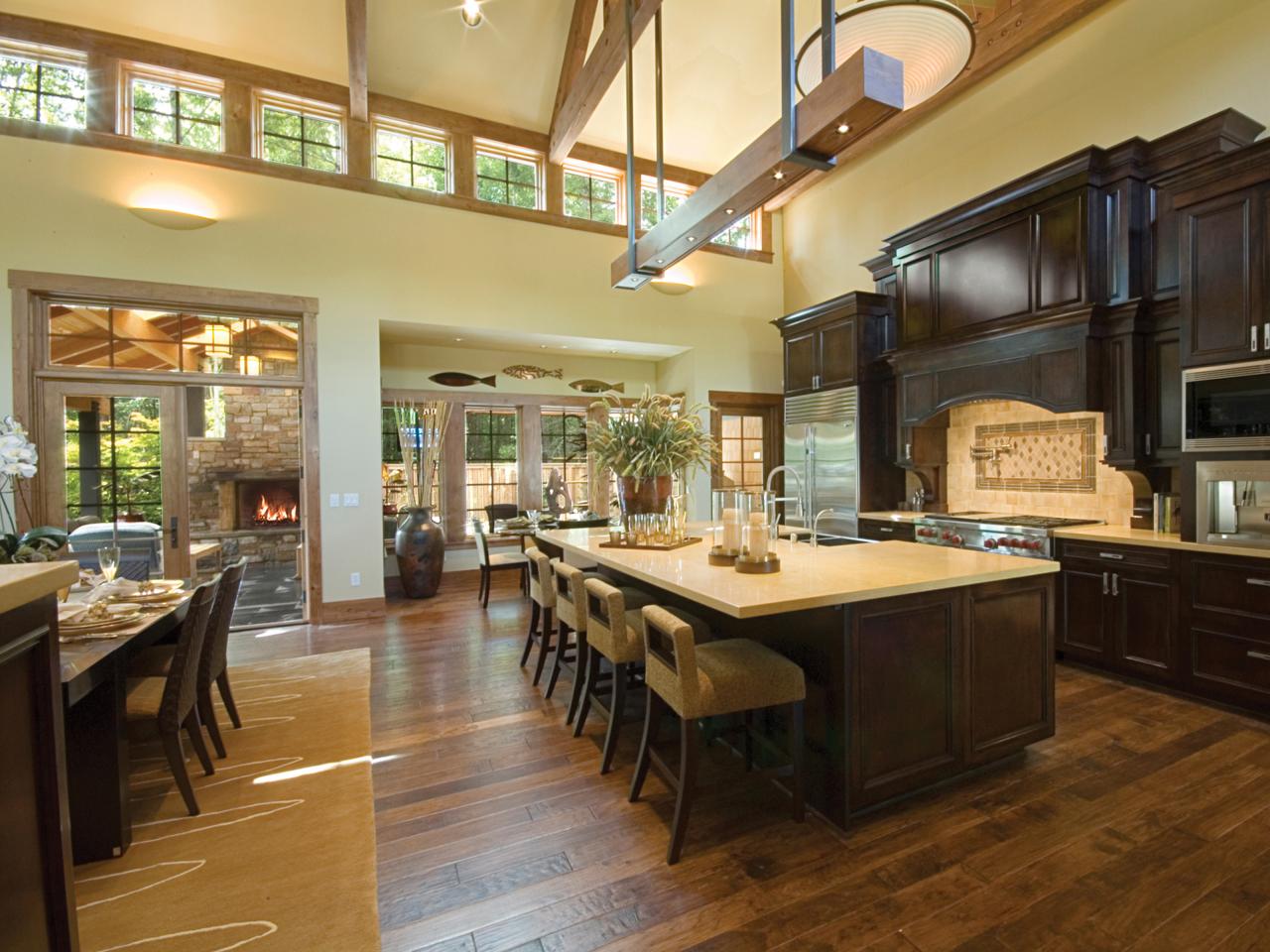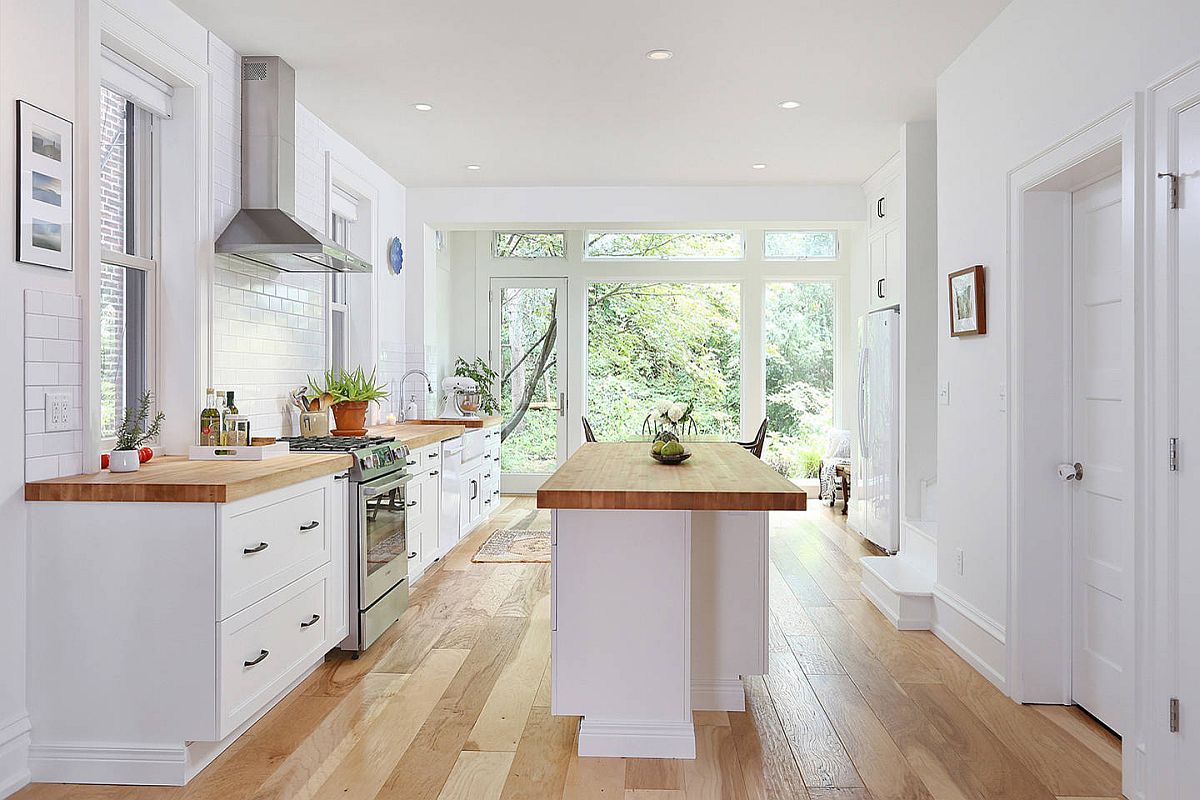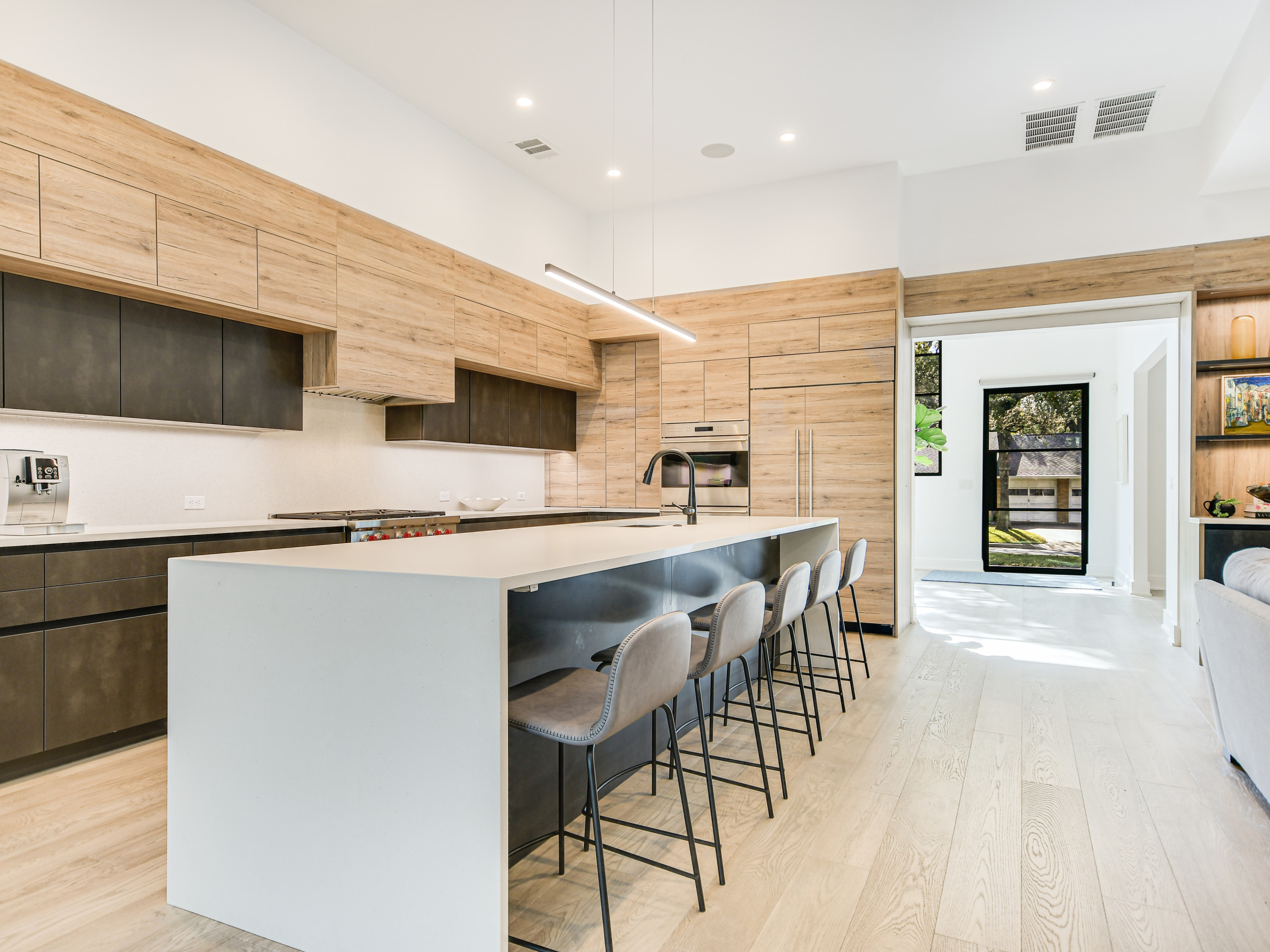Timeless Appeal of Wooden Floors in Kitchens
Wooden floors have an undeniable charm that has stood the test of time, especially in kitchens. There’s something inherently warm and inviting about the natural look of wood that makes any kitchen feel like the heart of the home. Here’s why wooden floors never go out of style.
- Natural Beauty: The first thing that draws people to wooden floors is their natural beauty. Each plank is unique, with its own grain and color variations, creating a truly one-of-a-kind floor. This individuality adds character to the kitchen, making it feel more personalized and homely.
- Versatility: Wooden floors are incredibly versatile and can complement almost any kitchen style, from rustic to modern. They come in various types, such as oak, maple, cherry, and walnut, each bringing its own unique look and feel. This versatility allows for endless design possibilities, ensuring that wooden floors can adapt to changing trends.
- Warmth and Comfort: Unlike tiles or concrete, wooden floors are naturally warm underfoot, which is particularly appreciated in a kitchen. The warmth of wood creates a cozy atmosphere, making the kitchen a more comfortable space to spend time in, whether you’re cooking, dining, or entertaining guests.
- Aging Gracefully: One of the most appealing aspects of wooden floors is that they age beautifully. Over time, they develop a patina that adds to their charm, giving the kitchen a timeless, lived-in look. This aging process enhances the wood’s character and can make it look even better with age.
- Increasing Home Value: Wooden floors are often seen as a premium feature in homes, and for good reason. They are durable, easy to maintain, and have a timeless appeal that can increase the value of your home. Potential buyers often appreciate the classic look of wooden floors, making your kitchen more attractive if you ever decide to sell.
- Sustainable Choice: Many people are drawn to wooden floors because they are an eco-friendly option. When sourced from sustainably managed forests, wood is a renewable resource that has a lower environmental impact compared to other flooring materials. Choosing wooden floors can be part of a larger commitment to environmentally responsible living.

Choosing the Right Wood for Your Kitchen Floor
Selecting the right wood for your kitchen floor is a crucial decision that can impact the overall look and functionality of your space. With so many options available, it can be overwhelming to decide which wood is best suited for your needs. Here’s a guide to help you make the right choice.
Consider Your Style: The type of wood you choose should complement the overall style of your kitchen. For a traditional or rustic look, oak and pine are excellent choices with their rich grains and warm tones. For a more contemporary or minimalist style, maple or birch with their smoother, lighter finishes might be more suitable.
Durability Matters: Kitchens are high-traffic areas, so it’s important to choose a wood that can withstand daily wear and tear. Hardwoods like oak, maple, and hickory are known for their durability and are less likely to dent or scratch compared to softer woods like pine. Consider the hardness rating of the wood, often referred to as the Janka scale, to ensure it meets your durability needs.
Maintenance Requirements: Different woods have different maintenance requirements. Some woods are more resistant to moisture and stains, making them easier to care for in a kitchen environment. For example, teak and bamboo are naturally resistant to water, making them ideal for kitchens where spills are common. On the other hand, woods like cherry may require more frequent sealing to maintain their appearance.
Color and Grain: The color and grain of the wood can significantly affect the overall aesthetic of your kitchen. Darker woods like walnut can add a sense of sophistication and contrast beautifully with lighter cabinetry. Lighter woods like ash can make a small kitchen feel more spacious and airy. The grain pattern, whether it’s straight, wavy, or knotty, also contributes to the visual interest of the floor.
Budget Considerations: The cost of wood flooring can vary widely depending on the type of wood, its grade, and the finish. Exotic woods like mahogany and Brazilian cherry tend to be more expensive, while domestic species like oak and maple are more budget-friendly. Consider your budget not only for the initial installation but also for long-term maintenance and potential refinishing.
Sustainability: If environmental impact is a concern, look for wood that is certified by the Forest Stewardship Council (FSC) or other reputable certification bodies. These certifications ensure that the wood is sourced from sustainably managed forests. Additionally, reclaimed wood is an excellent eco-friendly option that gives new life to old materials.
Durability and Maintenance: Keeping Your Wooden Floors Pristine
Wooden floors can last a lifetime if properly cared for, but they do require some maintenance to keep them looking their best. Understanding the durability and maintenance needs of your wooden kitchen floor is key to preserving its beauty and functionality. Here’s how you can ensure your wooden floors remain pristine.
Regular Cleaning: Keeping your wooden floors clean is the first step in maintaining their beauty. Sweep or vacuum regularly to remove dirt and debris that can scratch the surface. Use a damp mop with a wood-friendly cleaner for deeper cleaning, but avoid excessive water, as it can damage the wood over time.
Preventing Scratches and Dents: Kitchens are high-traffic areas, and your floors will inevitably encounter some wear and tear. To minimize scratches and dents, use felt pads under furniture legs and avoid dragging heavy items across the floor. Place mats at entryways to trap dirt and grit before it can scratch the floor.
Dealing with Spills: Spills are bound to happen in a kitchen, but it’s important to clean them up promptly to prevent staining and water damage. Use a soft cloth to blot (not rub) the spill, and then clean the area with a wood-safe cleaner. For tougher stains, a mixture of vinegar and water can be effective.
Humidity Control: Wood is sensitive to changes in humidity, which can cause it to expand and contract. To prevent warping and gaps, maintain a consistent indoor humidity level of around 30-50%. Use a humidifier in the winter and a dehumidifier in the summer if necessary. This will help keep your wooden floors stable and looking their best.
Periodic Refinishing: Over time, even the most well-maintained wooden floors will show signs of wear. Periodic refinishing can restore their original luster. Depending on the level of traffic and wear, you might need to refinish your floors every 5-10 years. Sanding down the surface and applying a fresh coat of finish can make your floors look brand new.
Protective Measures: Consider using area rugs or runners in high-traffic areas like in front of the sink or stove. This not only adds a decorative element but also provides an extra layer of protection for your floors. Just make sure to use rug pads that are safe for wood floors to prevent any potential damage.
Balancing Aesthetics and Functionality with Wooden Floors
When designing a kitchen, finding the perfect balance between aesthetics and functionality can be challenging, especially when it comes to wooden floors. Here’s how you can achieve both beauty and practicality with wooden floors in your kitchen.
Choosing the Right Finish: The finish you choose for your wooden floors can greatly impact both their appearance and durability. A matte finish can hide scratches and wear better than a glossy finish, making it ideal for high-traffic areas like kitchens. On the other hand, a satin finish offers a good balance between sheen and practicality, providing a sleek look that is also easy to maintain.
Color Coordination: Coordinating the color of your wooden floors with your kitchen cabinets, countertops, and walls is crucial for a harmonious design. Lighter wood floors can make a kitchen feel more open and airy, while darker floors can add depth and richness. Consider the overall color palette of your kitchen and choose a wood tone that complements it without overwhelming the space.
Functional Layout: The layout of your kitchen can influence the type of wood and installation method you choose. For example, wider planks can make a small kitchen feel larger, while herringbone or chevron patterns can add visual interest to a more expansive space. Consider how the layout will affect the flow and functionality of the kitchen, and choose a flooring pattern that enhances the overall design.
Integration with Kitchen Elements: Wooden floors can seamlessly integrate with various kitchen elements, such as islands, cabinetry, and appliances. To achieve a cohesive look, consider using wood accents in other parts of the kitchen, such as a wooden countertop or open shelving. This creates a unified design that ties everything together beautifully.
Practical Considerations: While aesthetics are important, practicality should not be overlooked. Ensure that the wooden floors are sealed properly to protect against spills and moisture. Opt for high-quality finishes that offer better resistance to stains and scratches. Additionally, consider the ease of cleaning and maintenance when choosing the type of wood and finish for your kitchen floors.
Personal Touches: Adding personal touches to your kitchen design can make it truly unique. Consider incorporating reclaimed wood for a rustic, eco-friendly touch, or using a combination of wood types to create a custom look. Personalizing your wooden floors can make your kitchen feel more like your own, adding to both its beauty and functionality.
Eco-Friendly Options for Wooden Kitchen Floors
As sustainability becomes increasingly important, many homeowners are seeking eco-friendly options for their wooden kitchen floors. Here’s how you can choose environmentally responsible flooring without compromising on style or quality.
Reclaimed Wood: One of the most eco-friendly options is reclaimed wood, which repurposes old wood from barns, factories, and other structures. This not only reduces the demand for new lumber but also gives new life to materials that would otherwise go to waste. Reclaimed wood floors have a unique character and history, adding a distinctive charm to your kitchen.
Bamboo Flooring: Although technically a grass, bamboo is often considered an excellent alternative to traditional hardwoods due to its rapid growth rate and sustainability. Bamboo flooring is durable, easy to maintain, and available in various finishes. Look for products that are certified by reputable organizations to ensure they are produced in an environmentally responsible manner.
Cork Flooring: Cork is another sustainable option that is harvested from the bark of the cork oak tree, which regenerates after harvesting. This makes cork a renewable resource. Cork flooring is naturally resistant to mold, mildew, and pests, making it ideal for kitchens. It also provides a comfortable and cushioned surface, which can be a bonus for those who spend a lot of time cooking.
FSC-Certified Wood: When choosing new wood, look for products certified by the Forest Stewardship Council (FSC). This certification ensures that the wood is sourced from responsibly managed forests that meet stringent environmental and social standards. FSC-certified wood is available in many species and finishes, allowing you to choose a sustainable option that fits your design preferences.
Engineered Wood: Engineered wood flooring is made from layers of wood veneer bonded together, which can make more efficient use of resources compared to solid hardwood. Opt for engineered wood that uses a high percentage of recycled or rapidly renewable materials. This type of flooring often comes with a durable finish that extends its lifespan, further reducing its environmental impact.
Non-Toxic Finishes: The finish on your wooden floors can also impact their eco-friendliness. Look for finishes that are low in volatile organic compounds (VOCs) and other harmful chemicals. Water-based finishes are generally more environmentally friendly than oil-based ones. Choosing non-toxic finishes not only benefits the environment but also improves indoor air quality for you and your family.
Cost Considerations: Budgeting for Wooden Floor Installation
Installing wooden floors in your kitchen can be a significant investment, but understanding the cost considerations can help you budget effectively. Here’s a guide to help you navigate the expenses involved in wooden floor installation.
Material Costs: The type of wood you choose will greatly influence the overall cost. Domestic hardwoods like oak and maple are generally more affordable, while exotic woods like mahogany and Brazilian cherry can be significantly more expensive. Engineered wood and bamboo are often cost-effective alternatives that still offer the look and feel of traditional hardwood.
Installation Costs: The cost of installation can vary depending on the complexity of the job and the type of flooring. Professional installation is recommended for most wooden floors to ensure a high-quality finish and longevity. Installation costs typically include labor, subfloor preparation, and any additional materials needed. On average, you can expect to pay between $4 and $8 per square foot for installation.
Preparation and Removal: If you need to remove existing flooring before installing new wooden floors, this can add to the overall cost. The condition of the subfloor will also affect the preparation costs. If the subfloor needs to be repaired or leveled, this will increase the expense. It’s important to factor these potential costs into your budget to avoid surprises.
Finishing and Sealing: The finishing process, which includes sanding, staining, and sealing, can add to the cost of your wooden floors. Pre-finished wood can save you money on this step, as it comes with the finish already applied. However, site-finished wood allows for more customization in terms of color and sheen. Consider the pros and cons of each option when budgeting for your project.
Long-Term Maintenance: Wooden floors require ongoing maintenance to keep them looking their best. This includes regular cleaning, occasional refinishing, and potential repairs. While the initial cost of wooden floors can be high, their longevity and ability to be refinished can make them a cost-effective choice in the long run. Plan for periodic maintenance costs to ensure your floors remain in top condition.
Warranty and Insurance: When investing in wooden floors, it’s important to consider the warranty and potential insurance coverage. Many flooring manufacturers offer warranties that cover defects and certain types of damage. Additionally, check with your home insurance provider to see if your policy covers damage to your floors. Understanding the terms of these warranties and insurance policies can help protect your investment.
Pros & Cons of Hardwood Floors in a Portland Kitchen
Hottest Trending Kitchen Floor
Trending Kitchen Floor for 2024: Wood Floors Take Over
Beautiful Wood Floors In The Kitchen
Light Wood Floor Kitchen Ideas
Related Posts:
- Kitchen Tile Flooring Ideas
- Mid Century Kitchen Flooring
- Cheap Kitchen Floor Makeover
- Penny Tile Kitchen Floor
- Kitchen Floor Texture
- Bluestone Kitchen Floor
- Black Granite Kitchen Floor
- White Marble Kitchen Floor
- Tiny Kitchen Floor Plans
- Victorian Kitchen Floor Ideas
Welcome to the World of Kitchen Wooden Floor Designs!
Welcome to a world where warmth, elegance, and durability merge seamlessly to create the perfect foundation for your kitchen. In this enchanting realm, we explore the incredible range of kitchen wooden floor designs that can transform your cooking space into a haven of beauty and functionality.
Imagine stepping into your kitchen and being greeted by the natural charm of a wooden floor. Its alluring grains, rich textures, and earthy hues instantly transport you to a serene and inviting atmosphere. With every step, you feel a gentle connection to nature, as if you’re dancing on forest leaves or strolling along a tranquil beach.
Our collection of kitchen wooden floor designs encompasses a wide spectrum of styles, from rustic farmhouse to modern minimalism. Whether you prefer the timeless appeal of classic oak or the exotic allure of bamboo, we have the perfect flooring option to suit your taste and elevate your kitchen’s aesthetic.
But it’s not just about aesthetics; our wooden floors are built to withstand the demands of a busy kitchen. They have been meticulously crafted to stand the test of time, ensuring durability that surpasses any other flooring material. Lesser floors may succumb to the wear and tear of spills, dropped utensils, and constant foot traffic, but our wooden floors endure it all with grace and resilience.
One of the remarkable benefits of kitchen wooden floor designs lies in their versatility. They effortlessly blend with any interior style, allowing you to adapt the atmosphere of the space. Whether you want to create a cozy and intimate area for family gatherings or a sleek, modern space for culinary masterpieces, our wooden floors provide endless possibilities for personalization.
But that’s not all; our kitchen wooden floor designs offer practical advantages as well. Wood possesses natural insulating properties, keeping your kitchen warm during colder months and cool during the scorching heat of summer. This energy efficiency not only enhances your comfort but also reduces your utility bills, making it a smart choice for the eco-conscious homeowner.
Furthermore, wood is a hygienic flooring option. Its smooth surface discourages the accumulation of dust, allergens, and pet dander, ensuring a cleaner and healthier environment for you and your loved ones. Unlike carpets that trap odors, wooden floors emanate a natural freshness, instilling harmony and serenity into your kitchen.
At the heart of our kitchen wooden floor designs lies a commitment to quality, authenticity, and sustainability. Each floorboard is carefully sourced from responsibly managed forests, promoting ecological balance and supporting local communities. By choosing our wooden floors, you’re not just investing in the beauty of your kitchen but also in the betterment of our planet.
So, come, let us embark on a journey through the enchanting world of kitchen wooden floor designs. Discover the multitude of options available and let your imagination flourish. With our exquisite designs and enduring quality, your kitchen will become a true masterpiece, luring you in with its irresistible charm every day.
